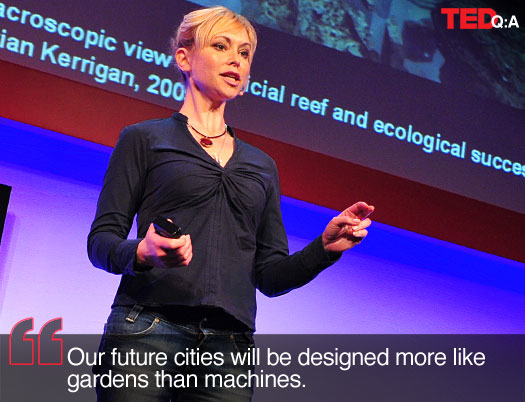What will the urban areas of tomorrow look like? More like an ever-changing and vibrant garden than a static set of buildings and blocks. In our new ebook Living Architecture: How Synthetic Biology Can Remake Our Cities and Reshape Our Lives, British designer and architect Rachel Armstrong re-imagines the world’s cities and argues that in order to achieve sustainable development of the built environment — and help countries like Japan recover from natural disasters — we need to rethink how we approach architecture. By genetically modifying biological systems and studying such things as protocells — nongenetic self-organizing molecules that exhibit movement and sensitivity to their surroundings — we could create more responsive and dynamic structures. The result is a new kind of architectural practice where cities behave more like an evolving ecosystem than a lifeless machine. We recently spoke with Armstrong.
What do you mean by ‘living architecture’?
It’s a way of using ecological solutions to urban problems. Living architecture works by applying new materials and engineered systems that harness some of the unique properties of ‘life.’ Living technology is more robust and environmentally responsive than traditional materials, and can deal with unpredictability in a way that current technologies cannot.
How?
Our future cities will be designed more like gardens than machines. Buildings will perform functions that we currently attribute to the plant world, such as carbon capture. They will also contribute to the health of residents by removing pollution or providing food and energy. Living architecture is not a panacea to urban problems, but propose an alternative approach to making buildings that may help alleviate these problem. Our cities, as they currently exist, as seen as inert barriers to the natural world. But these barriers are inevitably breached in the event of a natural disaster. What might happen if everyday buildings were designed with the seeds of regeneration?
What developments in biotech will make a difference?
Protocells, for one thing. Protocells are a very interesting technology in this new portfolio as they are not strictly speaking ‘alive’ – since they do not possess a biological set of instructions, such as DNA – but they do behave in a life-like manner. They can sense and move around their environment through chemical means. They can function together in groups and can be chemically programmed to lay down solid materials. They are one kind of living technology that will be part of a whole new portfolio of materials that architects will have at their disposal as they develop of our cities. These materials will literally transform inert, non-living building surfaces into dynamic, life-like ones that carry out a set of functions normally associated with ‘life,’ such as, growth, self-repair or recycling resources, like oil and water.
How far out are these concepts? When will we start to see them in play?
These technologies already exist in the laboratory and in prototype model form, although they still need research and development to turn them into widely available products. The ideas may seem outlandish but they are based on real technology that exists today. All applications of scientific research in the laboratory remain speculative until they are transformed into products. But we are heading that way.
Living Architecture: How Synthetic Biology Can Remake Our Cities and Reshape Our Lives is part of the TED Books series, which is available for the Kindle and Nook as well as on Apple’s iBookstore.

Comments (4)
Pingback: SuperLongevityMusic » Blog Archive » Tesla To Appear And Perform at 2012 Extreme Futurist Festival in LA